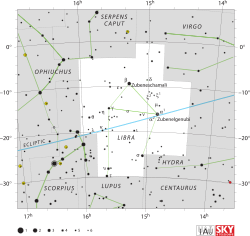Sigma Librae

| |
| Observation data Epoch J2000.0 Equinox J2000.0 (ICRS) | |
|---|---|
| Constellation | Libra |
| Right ascension | 15h 04m 04.21608s[1] |
| Declination | –25° 16′ 55.0606″[1] |
| Apparent magnitude (V) | +3.29[2] |
| Characteristics | |
| Spectral type | M3/M4 III[3] |
| U−B color index | +1.94[2] |
| B−V color index | +1.70[2] |
| Variable type | Semi-regular[4] |
| Astrometry | |
| Radial velocity (Rv) | –4.2[5] km/s |
| Proper motion (μ) | RA: –71.16[1] mas/yr Dec.: −43.34[1] mas/yr |
| Parallax (π) | 11.31 ± 0.25[1] mas |
| Distance | 288 ± 6 ly (88 ± 2 pc) |
| Absolute magnitude (MV) | –1.5[4] |
| Details | |
| Mass | 2.1[6] M☉ |
| Surface gravity (log g) | 0.9 ± 0.3[7] cgs |
| Temperature | 3,600[6] K |
| Metallicity [Fe/H] | 0.00[7] dex |
| Other designations | |
Sigma Librae (σ Lib, σ Librae) is a star in the constellation Libra. The apparent visual magnitude is +3.29,[2] making it a third magnitude star that is visible to the naked eye. Based upon parallax measurements, this star is at a distance of roughly 288 light-years (88 parsecs) from Earth, with a 2% margin of error.[1] At that distance, the visual magnitude of the star is diminished by 0.20 ± 0.17 from extinction caused by intervening gas and dust.[7]
Names
The star was originally given the Bayer designation "Gamma Scorpii"[9] (γ Sco). It did not receive its current Bayer designation as Sigma Librae until the 19th century. The new name was agreed upon by Commission 3 of the International Astronomical Union on July 31, 1930.[10]
It has the Latin names Brachium "arm" and Cornu "horn", and the non-unique minor Arabic names Zuben el Genubi "southern claw" (which it shares with Alpha Librae), Zuben Hakrabi (which it shares with Gamma Librae and Eta Librae [the latter also rendered Zuban Alakrab), and Ankaa (which it shares with Alpha Phoenicis).
Properties
Sigma Librae has a spectral class M3/M4 III,[3] which places it in the red giant stage of its evolution. This is a semi-regular variable star with a single pulsation period of 20 days.[4] It shows small amplitude variations in magnitude of 0.10–0.15 on time scales as brief as 15–20 minutes, with cycles of repetition over intervals of 2.5–3.0 hours.[11] This form of variability indicates that the star is on the asymptotic giant branch and is generating energy through the nuclear fusion of hydrogen and helium along concentric shells surrounding an inert core of carbon and oxygen.[12]
References
- 1 2 3 4 5 6 van Leeuwen, F. (November 2007), "Validation of the new Hipparcos reduction", Astronomy and Astrophysics, 474 (2): 653–664, arXiv:0708.1752
 , Bibcode:2007A&A...474..653V, doi:10.1051/0004-6361:20078357.
, Bibcode:2007A&A...474..653V, doi:10.1051/0004-6361:20078357. - 1 2 3 4 Nicolet, B. (1978), "Photoelectric photometric Catalogue of homogeneous measurements in the UBV System", Astronomy and Astrophysics Supplement Series, 34: 1–49, Bibcode:1978A&AS...34....1N.
- 1 2 Houk, Nancy (1978), Michigan catalogue of two-dimensional spectral types for the HD stars, 4, Ann Arbor: Dept. of Astronomy, University of Michigan, Bibcode:1988mcts.book.....H.
- 1 2 3 Yeşilyaprak, C.; Aslan, Z. (December 2004), "Period-luminosity relation for M-type semiregular variables from Hipparcos parallaxes", Monthly Notices of the Royal Astronomical Society, 355 (2): 601–607, Bibcode:2004MNRAS.355..601Y, doi:10.1111/j.1365-2966.2004.08344.x.
- ↑ Wielen, R.; et al. (1999), Sixth Catalogue of Fundamental Stars (FK6). Part I. Basic fundamental stars with direct solutions (35), Astronomisches Rechen-Institut Heidelberg, Bibcode:1999VeARI..35....1W.
- 1 2 Tsuji, Takashi (May 2007), "Isotopic abundances of Carbon and Oxygen in Oxygen-rich giant stars", in Kupka, F.; Roxburgh, I.; Chan, K., Convection in Astrophysics, Proceedings of IAU Symposium #239 held 21-25 August, 2006 in Prague, Czech Republic, pp. 307–310, arXiv:astro-ph/0610180
 , Bibcode:2007IAUS..239..307T, doi:10.1017/S1743921307000622.
, Bibcode:2007IAUS..239..307T, doi:10.1017/S1743921307000622. - 1 2 3 Dehaes, S.; et al. (September 2011), "Structure of the outer layers of cool standard stars", Astronomy & Astrophysics, 533: A107, Bibcode:2011A&A...533A.107D, doi:10.1051/0004-6361/200912442
- ↑ "sig Lib -- Semi-regular pulsating Star", SIMBAD, Centre de Données astronomiques de Strasbourg, retrieved 2012-01-14.
- ↑ Burnham, Robert (1978), Burnham's celestial handbook: an observer's guide to the universe beyond the Solar System, Dover Books on Astronomy, 2 (2nd ed.), Courier Dover Publications, p. 1108, ISBN 0486235688.
- ↑ "Report of Commissions: Ephemerides", Transactions of the International Astronomical Union, 4: 20, 1932.
- ↑ Ruban, E. V.; Arkharov, A. A. (December 2010), "Microvariability and fast variability of stars. II. The semiregular red giants L2 Pup, 2 Cen, η Gem, and σ Lib", Astrophysics, 53 (4): 523–535, Bibcode:2010Ap.....53..523R, doi:10.1007/s10511-010-9144-7.
- ↑ Lebzelter, T.; Hron, J. (January 2008), "BRITE stars on the AGB", Communications in Asteroseismology, 152: 178–181, Bibcode:2008CoAst.152..178L, doi:10.1553/cia152s178
External links
- Kaler, James B., "ZUBENHAKRABI (Sigma Librae = Gamma Scorpii)", Stars, University of Illinois, retrieved 2012-03-22